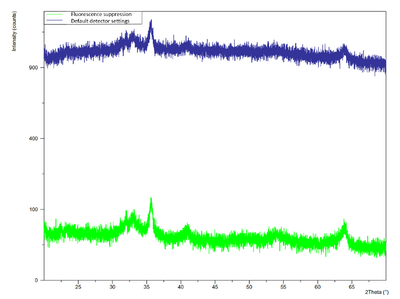Specific Process Knowledge/Characterization/XRD/XRD Powder/Measurement tips: Difference between revisions
| (2 intermediate revisions by the same user not shown) | |||
| Line 5: | Line 5: | ||
Some helpful tips can now be found in the [https://labmanager.dtu.dk/d4Show.php?id=6584&mach=463#dafs72253 manual on LabManager], section 4. They are mostly copied from the XRDMP Creater help document, which we for copyright reasons do not make available here. | Some helpful tips can now be found in the [https://labmanager.dtu.dk/d4Show.php?id=6584&mach=463#dafs72253 manual on LabManager], section 4. They are mostly copied from the XRDMP Creater help document, which we for copyright reasons do not make available here. | ||
A detailed manual on the Aeris XRD is found online on the [https://wiki.iodp.tamu.edu/display/LMUG/Aeris+Advanced+User+Guide wiki of the International Ocean Discovery Project]. It | A detailed manual on the Aeris XRD is found online on the [https://wiki.iodp.tamu.edu/display/LMUG/Aeris+Advanced+User+Guide wiki of the International Ocean Discovery Project]. It has helpful hints on adjusting the hardware including choices on beam knife height and slit size, more focused on geological samples but otherwise similar to what we write in the Nanolab manual for the XRD Powder. | ||
==Fluorescence suppression== | ==Fluorescence suppression== | ||
Latest revision as of 16:24, 13 May 2024
Feedback to this page: click here
Choosing measurement parameters
Some helpful tips can now be found in the manual on LabManager, section 4. They are mostly copied from the XRDMP Creater help document, which we for copyright reasons do not make available here.
A detailed manual on the Aeris XRD is found online on the wiki of the International Ocean Discovery Project. It has helpful hints on adjusting the hardware including choices on beam knife height and slit size, more focused on geological samples but otherwise similar to what we write in the Nanolab manual for the XRD Powder.
Fluorescence suppression
It is possible to adjust the Pulse Height Discrimination levels of the Pixcel 1D detector on our machine. This can help suppress signal from fluorescence, which is at a slightly different energy level than the pure copper K-alpha signal. The exact energy level of the fluorescence of course depends on the material you are measuring.
Here is a comparison of a measurement of FeOH with and without fluorescence suppression (green with fluorescence suppression, blue without, rather noisy / quick measurement done here but you see the difference in background intensity very clearly):

